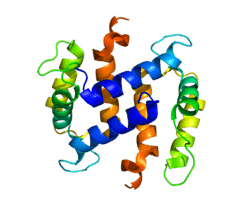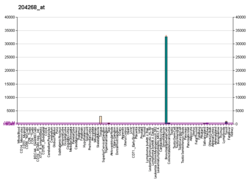S100A2
S100 calcium-binding protein A2 (S100A2) is a protein that in humans is encoded by the S100A2 gene [3] and it is located on chromosome 1q21 with other S100 proteins.
| S100A2 | |||||||||||||||||||||||||
|---|---|---|---|---|---|---|---|---|---|---|---|---|---|---|---|---|---|---|---|---|---|---|---|---|---|
 | |||||||||||||||||||||||||
| |||||||||||||||||||||||||
| Identifiers | |||||||||||||||||||||||||
| Aliases | S100A2, CAN19, S100L, S100 calcium binding protein A2 | ||||||||||||||||||||||||
| External IDs | OMIM: 176993 HomoloGene: 48389 GeneCards: S100A2 | ||||||||||||||||||||||||
| |||||||||||||||||||||||||
| |||||||||||||||||||||||||
| |||||||||||||||||||||||||
| Orthologs | |||||||||||||||||||||||||
| Species | Human | Mouse | |||||||||||||||||||||||
| Entrez |
| ||||||||||||||||||||||||
| Ensembl |
| ||||||||||||||||||||||||
| UniProt |
| ||||||||||||||||||||||||
| RefSeq (mRNA) |
| ||||||||||||||||||||||||
| RefSeq (protein) |
| ||||||||||||||||||||||||
| Location (UCSC) | Chr 1: 153.56 – 153.57 Mb | n/a | |||||||||||||||||||||||
| PubMed search | [2] | n/a | |||||||||||||||||||||||
| Wikidata | |||||||||||||||||||||||||
| |||||||||||||||||||||||||
Tissue and subcellular distribution
S100A2, also known as CaN19 or S100L was first isolated from bovine lung tissue.[4] However, in human tissue it was discovered several years later, in the mammary epithelial cells.[5] Under normal circumstances it is highly expressed in human lungs, prostate, kidneys, hair follicles and salivary and mammary glands.[6] S100A2 is predominantly found in the nucleus, which is not very common in other S100 proteins. Moreover, it can also be found in the cytoplasm, and its distribution is rather diffuse. Its occurrence in cytoplasm is most likely dependent on calcium levels in the cell.[7][8][9] In the extracellular environment, it can be found as a homodimer in vivo and in vitro, but it also exists in monomeric, polymeric and multimeric forms. In multimeric form, it functions as a RAGE receptor ligand.[10]
Function
S100A2 is important in cytoskelet organization.[11] Also, S100A2 is induced by p53, which it interacts and participates in the transcription of p21.[12][13] It also plays a role in differentiation, regeneration of tissues and healing[14][15] and it was shown it attract eosinophils by chemotaxis.[16]
Clinical significance
Its expression is reduced in many types of cancer, thereby distinguishing the cancerous expression profile of the other proteins of the S100 group.[17][18][19] It has been reported that S100A2 is downregulated in lung, kidney, prostate cancer and melanoma.[17] Chromosomal rearrangements and altered expression of this gene have also been implicated in breast cancer.[20] [21][8] In addition, its decline is associated with poor prognosis, disease progression, increased occurrence of metastasis and increased patient mortality.[22] Although in most cancers it has been found in reduced levels, there are studies that show that in some cases it is overproduced.[23][24]
References
- GRCh38: Ensembl release 89: ENSG00000196754 - Ensembl, May 2017
- "Human PubMed Reference:". National Center for Biotechnology Information, U.S. National Library of Medicine.
- Engelkamp D, Schäfer BW, Mattei MG, Erne P, Heizmann CW (July 1993). "Six S100 genes are clustered on human chromosome 1q21: identification of two genes coding for the two previously unreported calcium-binding proteins S100D and S100E". Proceedings of the National Academy of Sciences of the United States of America. 90 (14): 6547–51. doi:10.1073/pnas.90.14.6547. PMC 46969. PMID 8341667.
- Glenney JR, Kindy MS, Zokas L (February 1989). "Isolation of a new member of the S100 protein family: amino acid sequence, tissue, and subcellular distribution". The Journal of Cell Biology. 108 (2): 569–78. doi:10.1083/jcb.108.2.569. PMC 2115452. PMID 2521861.
- Lee SW, Tomasetto C, Sager R (April 1991). "Positive selection of candidate tumor-suppressor genes by subtractive hybridization". Proceedings of the National Academy of Sciences of the United States of America. 88 (7): 2825–9. doi:10.1073/pnas.88.7.2825. PMC 51332. PMID 1849277.
- Wolf S, Haase-Kohn C, Pietzsch J (October 2011). "S100A2 in cancerogenesis: a friend or a foe?". Amino Acids. 41 (4): 849–61. doi:10.1007/s00726-010-0623-2. PMID 20521072.
- Zhang T, Woods TL, Elder JT (November 2002). "Differential responses of S100A2 to oxidative stress and increased intracellular calcium in normal, immortalized, and malignant human keratinocytes". The Journal of Investigative Dermatology. 119 (5): 1196–201. doi:10.1046/j.1523-1747.2002.19520.x. PMID 12445212.
- Ilg EC, Schäfer BW, Heizmann CW (November 1996). "Expression pattern of S100 calcium-binding proteins in human tumors". International Journal of Cancer. 68 (3): 325–32. doi:10.1002/(SICI)1097-0215(19961104)68:3<325::AID-IJC10>3.0.CO;2-7. PMID 8903474.
- Mueller A, Schäfer BW, Ferrari S, Weibel M, Makek M, Höchli M, Heizmann CW (August 2005). "The calcium-binding protein S100A2 interacts with p53 and modulates its transcriptional activity". The Journal of Biological Chemistry. 280 (32): 29186–93. doi:10.1074/jbc.M505000200. PMID 15941720.
- Deshpande R, Woods TL, Fu J, Zhang T, Stoll SW, Elder JT (September 2000). "Biochemical characterization of S100A2 in human keratinocytes: subcellular localization, dimerization, and oxidative cross-linking". The Journal of Investigative Dermatology. 115 (3): 477–85. doi:10.1046/j.1523-1747.2000.00078.x. PMID 10951287.
- Martonosi AN (1983). "The Regulation of Cytoplasmic Ca2+ Concentration in Muscle and Nonmuscle Cells". Muscle and Nonmuscle Motility. Elsevier: 233–357. doi:10.1016/b978-0-12-673001-2.50011-2. ISBN 9780126730012.
- Mueller A, Schäfer BW, Ferrari S, Weibel M, Makek M, Höchli M, Heizmann CW (August 2005). "The calcium-binding protein S100A2 interacts with p53 and modulates its transcriptional activity". The Journal of Biological Chemistry. 280 (32): 29186–93. doi:10.1074/jbc.M505000200. PMID 15941720.
- Kirschner RD, Sänger K, Müller GA, Engeland K (May 2008). "Transcriptional activation of the tumor suppressor and differentiation gene S100A2 by a novel p63-binding site". Nucleic Acids Research. 36 (9): 2969–80. doi:10.1093/nar/gkn132. PMC 2396407. PMID 18388131.
- van Dieck J, Brandt T, Teufel DP, Veprintsev DB, Joerger AC, Fersht AR (April 2010). "Molecular basis of S100 proteins interacting with the p53 homologs p63 and p73". Oncogene. 29 (14): 2024–35. doi:10.1038/onc.2009.490. PMID 20140014.
- Brown GL, Nanney LB, Griffen J, Cramer AB, Yancey JM, Curtsinger LJ, et al. (July 1989). "Enhancement of wound healing by topical treatment with epidermal growth factor". The New England Journal of Medicine. 321 (2): 76–9. doi:10.1056/NEJM198907133210203. PMID 2659995.
- Komada T, Araki R, Nakatani K, Yada I, Naka M, Tanaka T (March 1996). "Novel specific chemtactic receptor for S100L protein on guinea pig eosinophils". Biochemical and Biophysical Research Communications. 220 (3): 871–4. doi:10.1006/bbrc.1996.0496. PMID 8607858.
- Maelandsmo GM, Flørenes VA, Mellingsaeter T, Hovig E, Kerbel RS, Fodstad O (August 1997). "Differential expression patterns of S100A2, S100A4 and S100A6 during progression of human malignant melanoma". International Journal of Cancer. 74 (4): 464–9. doi:10.1002/(SICI)1097-0215(19970822)74:4<464::AID-IJC19>3.0.CO;2-9. PMID 9291441.
- Gupta S, Hussain T, MacLennan GT, Fu P, Patel J, Mukhtar H (January 2003). "Differential expression of S100A2 and S100A4 during progression of human prostate adenocarcinoma". Journal of Clinical Oncology. 21 (1): 106–12. doi:10.1200/JCO.2003.03.024. PMID 12506178.
- Liu D, Rudland PS, Sibson DR, Platt-Higgins A, Barraclough R (December 2000). "Expression of calcium-binding protein S100A2 in breast lesions". British Journal of Cancer. 83 (11): 1473–9. doi:10.1054/bjoc.2000.1488. PMC 2363420. PMID 11076656.
- "Entrez Gene: S100A2 S100 calcium binding protein A2".
- Liu D, Rudland PS, Sibson DR, Platt-Higgins A, Barraclough R (December 2000). "Expression of calcium-binding protein S100A2 in breast lesions". British Journal of Cancer. 83 (11): 1473–9. doi:10.1054/bjoc.2000.1488. PMC 2363420. PMID 11076656.
- Suzuki F, Oridate N, Homma A, Nakamaru Y, Nagahashi T, Yagi K, et al. (December 2005). "S100A2 expression as a predictive marker for late cervical metastasis in stage I and II invasive squamous cell carcinoma of the oral cavity". Oncology Reports. 14 (6): 1493–8. doi:10.3892/or.14.6.1493. PMID 16273244.
- Wang H, Zhang Z, Li R, Ang KK, Zhang H, Caraway NP, et al. (August 2005). "Overexpression of S100A2 protein as a prognostic marker for patients with stage I non small cell lung cancer". International Journal of Cancer. 116 (2): 285–90. doi:10.1002/ijc.21035. PMID 15800916.
- Masuda T, Ishikawa T, Mogushi K, Okazaki S, Ishiguro M, Iida S, et al. (March 2016). "Overexpression of the S100A2 protein as a prognostic marker for patients with stage II and III colorectal cancer". International Journal of Oncology. 48 (3): 975–82. doi:10.3892/ijo.2016.3329. PMC 4750537. PMID 26783118.
Further reading
- Schäfer BW, Heizmann CW (April 1996). "The S100 family of EF-hand calcium-binding proteins: functions and pathology". Trends in Biochemical Sciences. 21 (4): 134–40. doi:10.1016/S0968-0004(96)80167-8. PMID 8701470.
- Rasmussen HH, van Damme J, Puype M, Gesser B, Celis JE, Vandekerckhove J (December 1992). "Microsequences of 145 proteins recorded in the two-dimensional gel protein database of normal human epidermal keratinocytes". Electrophoresis. 13 (12): 960–9. doi:10.1002/elps.11501301199. PMID 1286667.
- Lee SW, Tomasetto C, Swisshelm K, Keyomarsi K, Sager R (March 1992). "Down-regulation of a member of the S100 gene family in mammary carcinoma cells and reexpression by azadeoxycytidine treatment". Proceedings of the National Academy of Sciences of the United States of America. 89 (6): 2504–8. doi:10.1073/pnas.89.6.2504. PMC 48687. PMID 1372446.
- Schäfer BW, Wicki R, Engelkamp D, Mattei MG, Heizmann CW (February 1995). "Isolation of a YAC clone covering a cluster of nine S100 genes on human chromosome 1q21: rationale for a new nomenclature of the S100 calcium-binding protein family". Genomics. 25 (3): 638–43. doi:10.1016/0888-7543(95)80005-7. PMID 7759097.
- Gimona M, Lando Z, Dolginov Y, Vandekerckhove J, Kobayashi R, Sobieszek A, Helfman DM (March 1997). "Ca2+-dependent interaction of S100A2 with muscle and nonmuscle tropomyosins". Journal of Cell Science. 110 ( Pt 5) (5): 611–21. PMID 9092943.
- Böni R, Burg G, Doguoglu A, Ilg EC, Schäfer BW, Müller B, Heizmann CW (July 1997). "Immunohistochemical localization of the Ca2+ binding S100 proteins in normal human skin and melanocytic lesions". The British Journal of Dermatology. 137 (1): 39–43. doi:10.1111/j.1365-2133.1997.tb03698.x. PMID 9274623.
- Groves P, Finn BE, Kuźnicki J, Forsén S (January 1998). "A model for target protein binding to calcium-activated S100 dimers". FEBS Letters. 421 (3): 175–9. doi:10.1016/S0014-5793(97)01535-4. PMID 9468301.
- Wicki R, Franz C, Scholl FA, Heizmann CW, Schäfer BW (October 1997). "Repression of the candidate tumor suppressor gene S100A2 in breast cancer is mediated by site-specific hypermethylation". Cell Calcium. 22 (4): 243–54. doi:10.1016/S0143-4160(97)90063-4. PMID 9481475.
- Franz C, Durussel I, Cox JA, Schäfer BW, Heizmann CW (July 1998). "Binding of Ca2+ and Zn2+ to human nuclear S100A2 and mutant proteins". The Journal of Biological Chemistry. 273 (30): 18826–34. doi:10.1074/jbc.273.30.18826. PMID 9668057.
- Mueller A, Bächi T, Höchli M, Schäfer BW, Heizmann CW (June 1999). "Subcellular distribution of S100 proteins in tumor cells and their relocation in response to calcium activation". Histochemistry and Cell Biology. 111 (6): 453–9. doi:10.1007/s004180050381. PMID 10429967.
- Stradal TB, Troxler H, Heizmann CW, Gimona M (May 2000). "Mapping the zinc ligands of S100A2 by site-directed mutagenesis". The Journal of Biological Chemistry. 275 (18): 13219–27. doi:10.1074/jbc.275.18.13219. PMID 10788426.
- Hoyaux D, Decaestecker C, Heizmann CW, Vogl T, Schäfer BW, Salmon I, et al. (June 2000). "S100 proteins in Corpora amylacea from normal human brain". Brain Research. 867 (1–2): 280–8. doi:10.1016/S0006-8993(00)02393-3. PMID 10837826.
- Deshpande R, Woods TL, Fu J, Zhang T, Stoll SW, Elder JT (September 2000). "Biochemical characterization of S100A2 in human keratinocytes: subcellular localization, dimerization, and oxidative cross-linking". The Journal of Investigative Dermatology. 115 (3): 477–85. doi:10.1046/j.1523-1747.2000.00078.x. PMID 10951287.
- Nagy N, Hoyaux D, Gielen I, Schäfer BW, Pochet R, Heizmann CW, et al. (January 2002). "The Ca2+-binding S100A2 protein is differentially expressed in epithelial tissue of glandular or squamous origin". Histology and Histopathology. 17 (1): 123–30. doi:10.14670/HH-17.123. PMID 11813862.
- Kyriazanos ID, Tachibana M, Dhar DK, Shibakita M, Ono T, Kohno H, Nagasue N (2002). "Expression and prognostic significance of S100A2 protein in squamous cell carcinoma of the esophagus". Oncology Reports. 9 (3): 503–10. doi:10.3892/or.9.3.503. PMID 11956617.
- Zhang T, Woods TL, Elder JT (November 2002). "Differential responses of S100A2 to oxidative stress and increased intracellular calcium in normal, immortalized, and malignant human keratinocytes". The Journal of Investigative Dermatology. 119 (5): 1196–201. doi:10.1046/j.1523-1747.2002.19520.x. PMID 12445212.
- Hibi K, Fujitake S, Takase T, Kodera Y, Ito K, Akiyama S, et al. (September 2003). "Identification of S100A2 as a target of the DeltaNp63 oncogenic pathway". Clinical Cancer Research. 9 (11): 4282–5. PMID 14519656.


